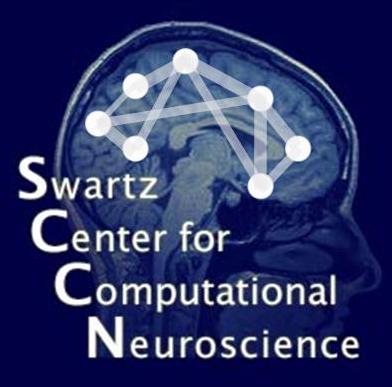
FMRLAB Tutorial
v 2.0©Jeng-Ren Duann & Scott Makeig, 2002
Swartz Center for Computational Neuroscience
Institute for Neural Computation
University of California San Diego
1. Introduction
This document provides a step-by-step guideline for new users of FMRLAB, a Matlab toolbox for fMRI data analysis using independent component analysis (ICA) available under the GNU public license. We first describe the procedures for installing the toolbox and then demonstrate how to use FMRLAB to analyze fMRI time series. The example dataset used in this tutorial is also available.
1.1 Theory and background
For background information about ICA and its application to fMRI data analysis, please refer to the references available here. FMRLAB has a counterpart, EEGLAB, for analyzing EEG or MEG data with ICA. EEGLAB can also be freely downloaded here. Some of the visualization functions FMRLAB uses to display ICA results are adapted from functions contained in SPM99, a Matlab-based program for brain imaging visualization and analysis that can be freely downloaded from the University College London.
1.2 Requirement
FMRLAB runs under core MATLAB (The MathWork, Inc., Natick, MA), version 5.3 or higher. Currently, the (somewhat faster) binary version of our ICA routine runica() (run from within Matlab using binica() has been compiled under Linux and FreeBSD only. On the visualization side, the incoperated SPM99 display functions (e.g., max intensity projection or MIP, 2-D slice overlay, and 3-D rendering) run only under Linux. For other platforms, please refer to SPM99 website and download the proper version of the related functions (see list in Appendix or the FMRLAB function list). FMRLAB requires at least 256 MB of RAM (more is better) and a Pentium III (or higher) CPU.
1.3 Processing time
The amount of processing required by FMRLAB is relatively modest. For example, applied to a conventional fMRI dataset, FMRLAB requires less than 10 minutes to preprocess and run ICA training using a laptop running Linux with 1.6 GHz Pentium IV CPU and 1 GB memory.
1.4 Image format
The image format used in FMRLAB is generic raw (.img) without header or footer. Thus, the experimenter needs to enter the image acquisition parameters (e.g., image width and height, number of slices, FOV, slice thinkness, TR, etc) as well as the experimental paradigm (e.g., total number of scans, stimulation onset asynchrony (SOA), etc) in the provided editor window. The FMRLAB distribution includes some MATLAB routines to convert fMR images to FMRLAB format, from different systems (Siemens Symphony, Siemens Magnetom, GE Signa 1.5/2.0 T and Bruker MedSpec S300 3T). Please refer to the FMRLAB home page for further details. To display independent component regions of activity (ROAs) using SPM99 MIP, 2-D slice overlay, or 3-D rendering displays, the data need to be converted to SPM ANALYZE format (Mayo Clinic, Rochester). FMRLAB includes a converter function for this purpose. Users of AFNI and SPM can save their image in AFNI's "brick" files or in Analyze format. FMRLAB can read data from these two image formats without further conversion.
Back to table of contents ...
To the next chapter: Installing FMRLAB ...